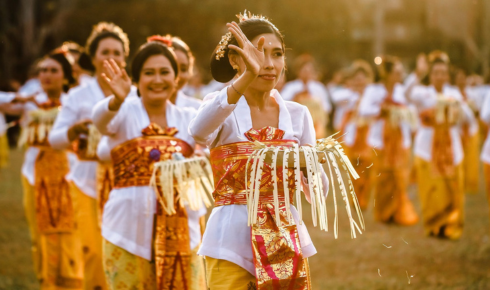Bali, Indonesia’s famed “Island of the Gods,” is not just about stunning beaches and luxury resorts—it’s a living tapestry of ancient customs, spiritual rituals, and vibrant cultural traditions. For travelers seeking more than just scenic beauty, experiencing these unique Balinese traditions offers a deeper connection to the island’s soul. Here are the most captivating customs you shouldn’t miss, many of which can be included in curated Bali trip packages for an immersive experience.
1. Melasti: The Sacred Purification CeremonyWhat It Is
Held before Nyepi (Balinese New Year), Melasti is a purification ritual where villagers carry sacred temple objects to the sea or holy springs.
Why Witness It
- Visual Spectacle: Locals in traditional white attire parade with intricate offerings.
- Cultural Insight: Represents the cleansing of sins and negative energies.
- Best Places to See It: Sanur Beach, Nusa Dua, or Tanah Lot—often included in Bali trip packages during March/April.
2. Ogoh-Ogoh Parade: The Night of the DemonsWhat It Is
On the eve of Nyepi, villages create Ogoh-Ogoh—massive papier-mâché demons symbolizing evil spirits—and parade them before burning them at midnight.
Why Witness It
- Thrilling Atmosphere: Drumming, chanting, and fiery culminations.
- Photographer’s Dream: The elaborate, grotesque sculptures are awe-inspiring.
- Where to Go: Denpasar or Ubud—ask tour operators about Nyepi-themed Bali trip packages.
3. Kecak Fire Dance: A Mesmerizing PerformanceWhat It Is
A hypnotic dance-drama set to a chanting choir of 50+ men, depicting scenes from the Hindu epic Ramayana, often ending with a fire-walking trance.
Why Witness It
- Unforgettable Ambiance: Performed at sunset, usually in open-air temples.
- Top Venues: Uluwatu Temple (cliffside backdrop) or Pura Dalem Taman Kaja (Ubud).
- Pro Tip: Many Bali trip packages include dinner-and-show combos.
4. Canang Sari: Daily Offerings to the GodsWhat It Is
Twice daily, Balinese women craft Canang Sari—small palm-leaf baskets filled with flowers, rice, and incense—as gratitude offerings.
Why Witness It
- Ubiquitous Beauty: Spot these offerings on sidewalks, shrines, and beaches.
- Participate: Some workshops (like in Ubud) teach you to make them.
5. Tooth Filing (Metatah): A Coming-of-Age RitualWhat It Is
A Hindu rite of passage where teens file their canine teeth to symbolically curb negative traits like greed and anger.
Why Witness It
- Rare Insight: Few tourists see this intimate ceremony.
- Where to Find It: Ask locals in Tabanan or Gianyar during Galungan festival times.
6. Subak: Bali’s Ancient Farming SystemWhat It Is
A UNESCO-listed cooperative water management system for rice terraces, dating back to the 9th century.
Why Witness It
- Scenic Beauty: Tegalalang or Jatiluwih terraces showcase this tradition.
- Cultural Depth: Learn how Balinese harmony with nature sustains agriculture.
7. Pengrupukan: The Battle of Good vs. EvilWhat It Is
Before Nyepi, families bang pots and light torches to drive away evil spirits—a noisy, exhilarating tradition.
Why Witness It
- Local Interaction: Join villagers in their courtyards for this raucous ritual.
Final Thoughts: How to Experience Balinese Traditions
To fully appreciate Bali’s living culture:
- Time Your Visit: Align with festivals like Nyepi (March) or Galungan (every 210 days).
- Choose Thoughtful Tours: Opt for Bali trip packages that include cultural workshops or temple ceremonies.
- Respect Customs: Dress modestly for temples, and never step on offerings.
Bali’s traditions are its heartbeat—witnessing them transforms a typical vacation into a profound journey. Ready to explore? Book a Bali trip package that celebrates the island’s heritage, and prepare to be enchanted.
“In Bali, every ritual whispers a story. Listen closely.”
Also Read: 7-Day Bali Itinerary 2025: A First-Timer’s Travel Blueprint!





